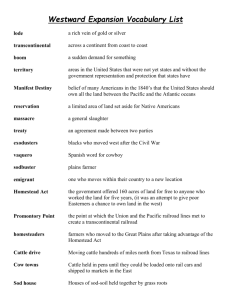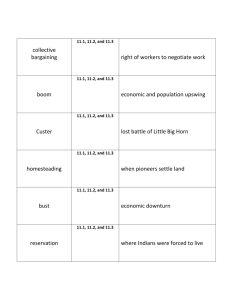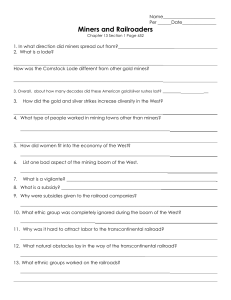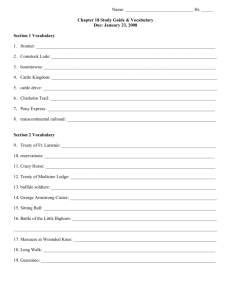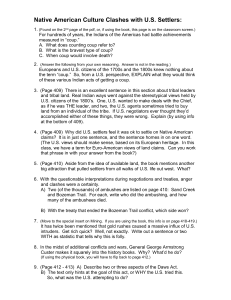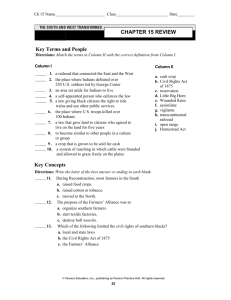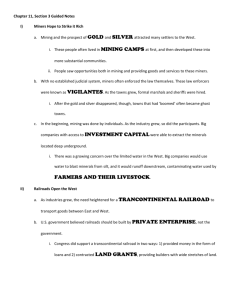Growth of Cattle Industry and Settling the Great Plains
advertisement
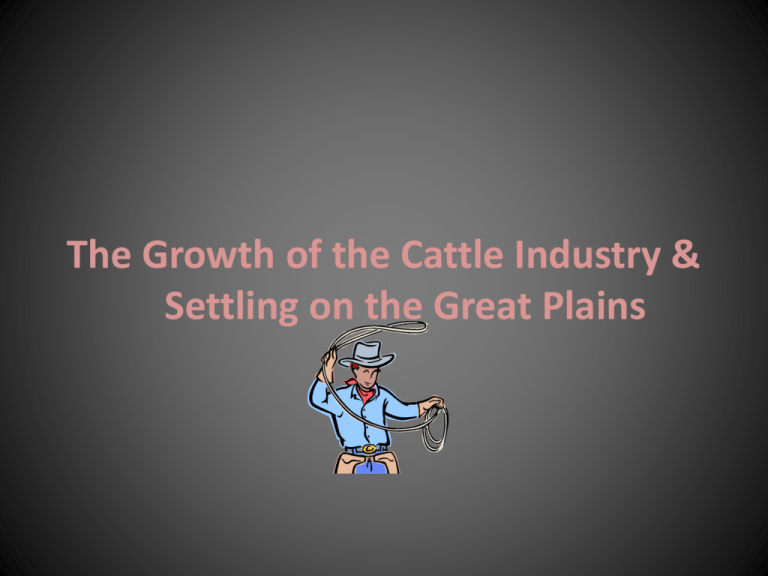
The Growth of the Cattle Industry & Settling on the Great Plains The Growth of the Cattle Industry “As settlers took over the Native American lands, they developed a thriving cattle industry. Learning skills and borrowing… from Mexicans, cowboy herded cattle and shipped them by railroad to growing cities in the east. The cowboy became one of America’s most romantic figures. By the 1880s… droughts, blizzards, and the introduction of barbed wire ended the cattle frontier.” Sports reference… #4. Growth of the Cattle Industry The Texas Longhorn Characterized by their horns (up to 8ft!) Not native to the United States, they were introduced by Spanish settlers in the 1500s. Before railroads, it was hunted and used primarily for hits hide. After railroads were built, the Longhorn became noted for its dairy and beef. The Transcontinental Railroad, Beef, and YOU! As settlers took Native Lands, they began to… settle… Farming Ranching Herding The Cowboy Known as the “Vaquero” in Mexico, the Cowboy was vital to the growth of the cattle industry. Before the railroad: Cattle were slaughtered for their hides After the railroad: Cattle could be transported to cities where food was in demand. Air conditioned cars. Air Conditioned Train Car The Boston Daily Advertiser (April 1869) "A refrigerator car... arrived in this city yesterday morning laden with 16,000 pounds of beef placed on board at Detroit on Wednesday of last week. This car was in charge of Mr. George H. Hammond on its passage. The ice is placed in narrow chambers at each side of the car, opening only at the top from outside, and does not, therefore, come in contact with the meat or the air in the car which is kept cold and dry. The meat was in better condition than that received directly from our home markets.” The Cowboy Cattle Dealer, Joseph McCoy desired to create a shipping yard where the trail would meet the rail. Abilene, Kansas, would become that city. From Abilene, cattle could be transported anywhere. Thus, the Chisholm Trail was born & ran from San Antonio to Abilene. The Cowboy 1 in 4 were African-American. 1 in 10 were Mexican. Often leading herds ranging from 1,000 to 4,000 or more, the Cowboy had a tough job. Come 1887, lasting just over 20 years, the Cowboy would see its end due to barbed wire and bad weather. Spring – Round up. Starve them, brand them, herd them. The Long Drive. Could last 3 months or more. City dwellers glorified the Cowboy for their life of “adventure”. Sleeping outdoors, riding horses, confronting Natives (not as frequent as one may believe.). Cities and Towns Prosper • Tacoma, Reno, Fresno, Cheyenne, Billings, Albuquerque all grew from the Railroad. • Chicago, St. Louis, Omaha, Sioux City all became major meat-packing centers. Settlers & Farmers By 1865, there were 20,000 pioneers who had migrated westward. By 1905, 500,000 more would become Homesteaders. However, over two million families would buy land from railroad companies, the government, or through other means. Settlers & Farmers 1884 – Five Transcontinental Railroads Settlers & Farmers • Farmers in the Great Plains experienced a variation of different hardships: • Floods, fires, droughts, blizzards, locusts, and the threat of Native Americans. The weather was the biggest threat. Thunder & lightning posed a large threat to both cowboys & settlers – Farmers lived in “soddies”. – Women had better opportunity in the Great Plains: • Ratio of men to women was about 100 to 1. • Women worked side by side with men and often owned land or businesses. Settlers & Farmers Inventions by John Deere (Steel Plow in 1837) and Cyrus McCormick (Reaping Machine in 1847), seed drills and barbed wire, made work easier. However, it would cast many farmers into debt. Morrill Land Grant Act of 1862 Passed to help support agricultural education by granting federal lands to states to form agricultural colleges. The Hatch Act of 1887 built agricultural research stations to make farming Improvements such as threads of grain that were able to survive in droughts. REVIEW! Review! What were some of the main reasons for the growth of the cattle industry in the USA? Growing population, transcontinental railroad. Review! What was the name of the cattle that we focused on? Where did it come from? Why was it used? The Texas Longhorn. Brought from Spain in 1500s. Very lean meat, good quality. Review! What impact did the Transcontinental Railroad have on settlers and Natives? The railroad removed Natives from their land opening it up to settlers to farm, herd, or ranch. Review! Before the railroad, what were cattle primarily used for? What inventions helped to move cattle across the country? Killed for hides. The railroad, the Chisholm Trail, and air conditioned cars helped move cattle. Review! Who had the idea to make trail meet rail with the Chisholm Trail? Where did it start and meet? Joseph McCoy. The trail started in San Antonio, Texas and met the rail at Abilene, Kansas. Review! Describe the duties of a cowboy. What kind of diversity did cowboys have? Corralling, herding, branding, etc… 1 in 4 = African-American 1 in 10 = Mexican Review! Name some of the cities that grew from the railroad & the cattle drive. Tacoma, Reno, Fresno, Cheyenne, Billings, Albuquerque all grew from the Railroad. Chicago, St. Louis, Omaha, Sioux City all became major meat-packing centers. Review! By 1884, how many Transcontinental Railroads were there? Five. Review! What were the threats that farmers & settlers experienced on the frontier? Floods, fires, droughts, blizzards, locusts, and the threat of Native Americans. Review! What were living conditions like on the Frontier? How were women treated? No wood = living in soddies. Women were often treated better than in cities and on coasts. Review! What did the Morrill Act of 1862 do? The Hatch Act of 1887? Morrill Act = Land Grant Colleges (A&M) Hatch Act = Built agricultural research stations
